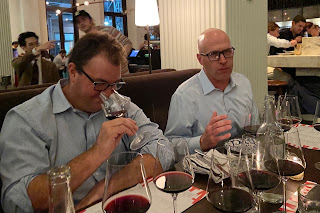Today is the last day of January, 2024, and tomorrow I will have my first alcoholic beverage in a month. Yes, this is the year I did
Dry January, 31 days of abstaining from one of the peak joys in my life.
I never had an interest in what seemed like a passing fad of post-holiday sobriety, yet this year was different. I've been more health-focused in general lately, and so a break from alcohol seemed like something I'd like to try.
After ringing in the New Year at an all-ladies Champagne party in Manhattan, I woke up late on New Year's Day to a protein-filled breakfast with coffee. The tee-totalling kept going from there.
How was my first Dry January? It was great! Surprisingly so. It made me realize that drinking wine, beer, or cocktails is something I enjoy but not something I need every week. I occasionally thought about the flavors I was missing - the honey and butter of a Burgundy white, the citrusy punch of a hoppy IPA, the carmel and oak flavors of my favorite whiskey. But, I didn't reach for these once.
Did I ever have a tough time during Dry January?
I wavered slightly after a long, emotional day. I was in the kind of self-pitying mood that seemed to call for a proper bottle of Italian red, maybe some chocolate, and definitely a guilty-pleasure Netflix session. But, I didn't have the kind of bottle I wanted at home, and it was too cold to walk to the wine store. So, I cooked another healthy dinner, drank herb tea, and didn't even have chocolate. The Netflix, however, was non-negotiable.
Were there benefits to Dry January?
I really enjoyed this month because it felt great to be intentional about what I was consuming. It was an exercise in self-care and a reason to focus on myself in a positive way. Eating more healthfully felt easier without having a glass of wine, which sometimes tempted me to a rich piece of cheese, and then some more nibbles.
Another plus is that I definitely saved money! Dining out when you are only sipping tap water is a sure way to save on the check.
One of the best things was just the knowledge that I stuck to the commitment I made to myself.
What was the hardest part of Dry January?
Socializing without joining my friends in alcohol was something I wasn't accustomed to. At a brunch gathering, I had to watch 8 friends order French 75s (oh, I like those), Negronis (and they looked delicious), and one pale pink glass of French Rose which looked divine. I drank a cappuccino, lots of water, and then a cup of Earl Gray. And I had a very good time - being with my friends was what mattered the most.
The hardest thing was the fear that I would feel awkward in some situations. For example, there was a work dinner while my boss was in town. Everyone on my team knows me as the "wine blogger," so I expected my colleages to be taken aback at my abstaining. While my boss seemed a little surprised, it wasn't a big deal.
After a few of these experiences, I realized that my not drinking wasn't important to anyone but me.
So what did I drink during Dry January?
Water, plain or flavored seltzer, club soda, seltzer with fruit juice or bitters or lemon or lime slices, coffee. But the real hero of Dry January was tea. Because my evening glass of wine became a hot mug of green tea with mint or tangerine-orange Zinger, or even a maple vanilla tea that my daughter gave me for Christmas. This was in addition to my daytime teas of Irish breakfast, Earl Gray, Lady Gray. These teas gave me the full, satisfying flavors I wanted, and were perfectly acceptable substitions for wine during this month.
What happens in February?
On February 1st, I have plans to attend a travel meetup at
Vol de Nuit, a Belgian Beer bar in downtown Manhattan, where I will order one of their delicious beers. And I'll go back to having wine with friends when we dine out - but maybe not as many glasses as before. And - for now - I do believe I'll drink less wine and other libations at home.
What about next Dry January?
I don't know if next year I'll do a full 31 days dry again - maybe I'll do more of a "damp" version that some of my friends have done this year. I do like the notion of a post-holiday easing up on alcohol, but it will depend on my inclination at the time. No matter what I decide in the future, I'm very happy for having had the Dry January experience this year.















